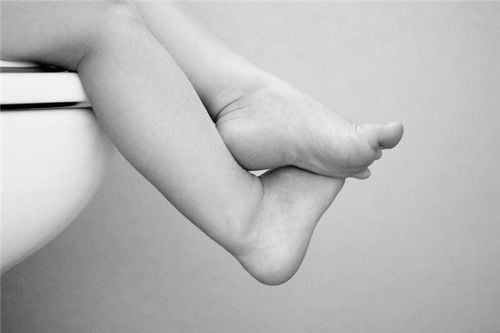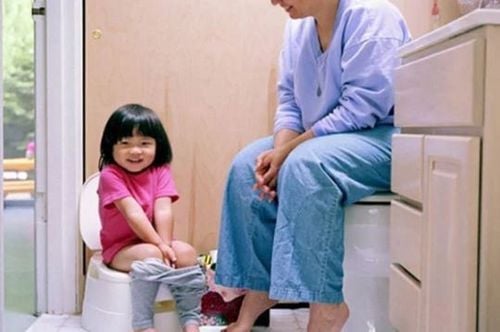This is an automatically translated article.
The article was written by Doctor Ho Thi Anh Thu - Department of Pediatrics - Neonatology - Vinmec Nha Trang International General Hospital.
Learning to use the toilet is an important milestone for both parents and children. For parents, this means that your baby no longer has to use diapers and you don't have to worry about your baby going to the bathroom. For children, this is a step towards independence and self-control. Before you start potty training, it's important to know if your child is ready, how to help your child, and what to do if problems arise.
1. Is the child ready?
Developmental Milestones: The age at which a child is ready to use the toilet depends on a number of factors and varies from child to child. Most children between the ages of two and four are able to use the toilet on their own during the day. Children going to the toilet at night can be months to years late.
Most experts agree that before starting toilet training, children need to be able to do the following:
Go to the toilet Sit on the toilet Hold urine for a few hours or not have bedwetting after napping Self pulling pants up and down Follows simple instructions Inform when need to go to the toilet Shows independence by saying "no" Shows interest in going to the toilet by himself Expresses desire (gifts, praise) Imitate adults and older children If your child has trouble with constipation, experts recommend getting it under control before you start toilet training. Chronic constipation can lead to painful bowel movements, obstructed stools, and children refusing to go to the bathroom.

2. Children with chronic illnesses and/or special needs
Children with chronic illnesses , such as asthma or sickle cell disease , or special needs do not necessarily start toilet training later than healthy children. In these cases, it may take longer for your baby to potty train and there may be failure, but with encouragement and patience with your baby, success is entirely possible.
Talk to your child's doctor for advice on toilet training your child with special needs. Special needs is an umbrella term for a wide range of problems, including cancer, developmental delays, mental and behavioral problems, and conditions that require special equipment (eg, nasogastric tubes). , trachea, walker).
Toilet training is not different for children with special needs, although you can help with a few things like:
Carrying the potty when the child cannot walk or crawling Help the child undress and wipe after going to the toilet when the child can't do it
3. Parents ready?
Parents also need to be ready to start the toilet training process. At least one parent will need to devote time and energy to potty training every day for at least three months.
Consider delaying toilet training if you're preparing for a new baby, moving to a new home, returning to work, or if your baby is new to daycare. Making too many changes at once can make potty training more difficult and increase the likelihood of failure.
There is truth in the face of pressure from grandparents, family members or teachers who may expect your child to go to the bathroom by a certain age. However, parents should also understand that toilet training is not a contest. Teaching your child to use the toilet on his own doesn't mean he's smarter or better than other kids.
Also, just because your child has difficulty toilet-training or starts to use the toilet at a later age doesn't mean your child is lazy, stubborn, or slow.

4. How long should children be taught?
The average time a child learns not to wet the bed is six months, and most children learn to control bowel movements before or at the same time they learn to urinate during the day. Not having bedwetting at night can be months to years late. Girls often go to the toilet on their own earlier than boys.
5. Start teaching your child to use the toilet
Toilet training involves many steps: talking, undressing, sitting, wiping, putting on pants, flushing, and washing hands. Repeat steps each time you go to the bathroom to help your child reinforce correct toilet skills.
Decide what words you will use to describe going to the bathroom and be consistent; Examples include pee, poop, potty. Remember that your child will use these words with adults and other children. Before you start practicing, change your baby's diaper often so he or she prefers a dry diaper. Buy a potty chair for your child. Initially, the potty seat was easier to use than the ottoman. Consider buying more than one chair if you have a multi-story home. Let your child decorate the potty chair and make it his own special chair. Place the potty chair in a convenient location, such as the child's playroom or bedroom. Encourage your child to sit on the potty, get fully dressed, look at a book, or play with a toy. Talk about how you would teach your child to use the toilet with a book or video. Regularly "run" to the potty chair, especially after waking up in the morning and after meals. After your child is comfortably seated, encourage your child to sit in a chair without a diaper. Place wet or soiled diapers in the potty to help your child understand dad's purpose. Encourage your child to tell you when he or she needs to go. Watch for signs that your child needs to go, like twisting or holding on to his genitals. Walk with your child to the potty and praise him when he gets into the chair on his own. Be patient as it may take days or weeks before your child succeeds. Do not punish, threaten, or yell at your child if he or she wets the bed or doesn't use the potty. Switch to cotton underwear after your child uses the potty chair. Put the diaper back on if the child still wets the bed. Rewards with medals or stickers with stickers can be helpful in encouraging your child to use the potty. Once your child has mastered the potty chair, he or she can be transitioned to the toilet seat. A stool for children to rest their feet when having a bowel movement will make it easier for them to have a bowel movement. Stools also help children feel more stable when sitting on an adult-sized toilet.

6. Some difficulties in teaching children to use the toilet
Toilet training can be a challenging process, with both success and failure. The most common problems that occur during toilet training include temporary impediment, bedwetting, and defecation.
Temporary Impediments It is completely normal for a child not to hold his urine, especially in the early stages of toilet training. Remind your child to use the potty when necessary, especially during denial, after meals, before going away and before going to bed.
Even when a child has mastered using the toilet, changes in his daily routine can cause bedwetting. If your child is not able to hold urine repeatedly after toilet training, contact your child's doctor to check for a UTI.
If your child is not making progress in toileting and he is still between the ages of two and four, you can pause teaching for 2 to 3 months. If your child is over four years old, healthy and still won't go to the bathroom on his own despite your and your child's efforts, talk to your child's doctor.
Bedwetting at bedtime Bedwetting is a common problem, occurring in 20% of 5-year-olds and 10% of 6-year-olds. You can read more about bed-wetting in the children's bed-wetting article.
Refuse to go to the toilet Up to 20% of children will refuse to go to the toilet. Some children willingly use the toilet to urinate but refuse to have a bowel movement. Instead, babies can hide and defecate in their diapers.
There are a number of possible reasons why a child refuses to go to the toilet. Most experts recommend doing the following:
Encourage your child. You can say to your child, “Poop is your friend. She really wants to go out. I'll help you!" Do not punish or nag the child. Stop potty training for a few weeks or months. Stop reminding your child to go to the toilet. Encourage your child to imitate you or a younger sibling by inviting them to the bathroom to watch them go to the bathroom. Encourage children to change their own diapers. Treat hard stools or constipation if needed. Painful or difficult bowel movements can lead to problems with toilet training and later digestion problems. You can reward your child with a badge or medal with a sticker for each time he or she tries and has a successful bowel movement. Please follow the website: Vinmec.com regularly to update many other useful information about child care.
Please dial HOTLINE for more information or register for an appointment HERE. Download MyVinmec app to make appointments faster and to manage your bookings easily.














